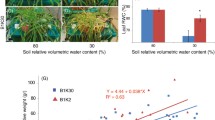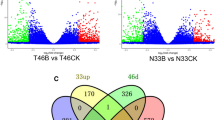Abstract
Salinity is a threat to crops in many parts of the world, and together with drought, it is predicted to be a serious constraint to food security. However, understanding the impact of this stressor on plants is a major challenge due to the involvement of numerous genes and regulatory pathways. While transcriptomic analyses of barley (Hordeum vulgare L.) under salt stress have been reported with microarrays, there are no reports as yet of the use of mRNA-Seq. We demonstrate the utility of mRNA-Seq by analysing cDNA libraries derived from acutely salt-stressed and unstressed leaf material of H. vulgare cv. Hindmarsh. The data yielded >50 million sequence tags which aligned to 26,944 sequences in the Unigene reference database. To gain maximum information, we performed de novo assembly of unaligned reads and discovered >3,800 contigs, termed novel tentative consensus sequences, which are either new, or significant improvements on current databases. Differential gene expression screening found 48 significantly up-regulated and 62 significantly down-regulated transcripts. The work provides comprehensive insights into genome-wide effects of salinity and is a new resource for the study of gene regulation in barley and wheat. Further, the bioinformatics workflow may be applicable to other non-model plants to establish their transcriptomes and identify unique sequences.



Similar content being viewed by others
References
Anders S, Huber W (2010) Differential expression analysis for sequence count data. Genome Biol 11:R106
Ando K, Grumet R (2010) Transcriptional profiling of rapidly growing cucumber fruit by 454-pyrosequencing analysis. J Amer Soc Hort Sci 135:291–302
Bartels D, Sunkar R (2005) Drought and salt tolerance in plants. Crit Rev Plant Sci 24:23–58
Close TJ (1996) Dehydrins: emergence of a biochemical role of a family of plant dehydration proteins. Physiol Plant 97:795–803
Druka A, Muehlbauer G, Druka I, Caldo R, Baumann U, Rostoks N, Schreiber A, Wise R, Close T, Kleinhofs A, Graner A, Schulman A, Langridge P, Sato K, Hayes P, McNicol J, Marshall D, Waugh R (2006) An atlas of gene expression from seed to seed through barley development. Funct Integr Genom 6:202–211
Du Z, Zhou X, Ling Y, Zhang Z, Su Z (2010) agriGO: a GO analysis toolkit for the agricultural community. Nucleic Acids Res 38(Suppl 2):w64–w70
Food and Agriculture Organisation of the United Nations (2005) Management of irrigation-induced salt-affected soils ftp://ftp.fao.org/agl/agll/docs/salinity_brochure_eng.pdf
Forrest KL, Bhave M (2007) Major intrinsic proteins (MIPs) in plants: a complex gene family with major impacts on plant phenotype. Funct Integr Genom 7:263–289
Garg R, Patel RK, Tyagi AK, Jain M (2011) De novo assembly of chickpea transcriptome using short reads for gene discovery and marker identification. DNA Res 18:53–63
Grains Research & Development Corporation (2008) GRDC impact assessment report series: an economic analysis of GRDC’s investment in barley breeding http://www.grdc.com.au/uploads/documents/GRDC_ImpAss_BarleyBreeding1.pdf
Hoagland DR, Arnon DI (1950) The water culture method for growing plants without soil. University of California Agric, Exp station, Berkley Circular 347
Hou X, Tong H, Selby J, Dewitt J, Peng X, He ZH (2005) Involvement of a cell wall-associated kinase, WAKL4, in Arabidopsis mineral responses. Plant Physiol 139:1704–1716
International Barley Genome Sequencing Consortium, Mayer KF, Waugh R, Brown JW, Schulman A, Langridge P, Platzer M, Fincher GB, Muehlbauer GJ, Sato K, Close TJ, Wise RP, Stein N (2012) A physical, genetic and functional sequence assembly of the barley genome. Nature 29:711–716
Kawaura K, Mochida K, Ogihara Y (2008) Genome-wide analysis for identification of salt-responsive genes in common wheat. Funct Integr Genom 8:277–286
Langridge P, Paltridge N, Fincher G (2006) Functional genomics of abiotic stress tolerance in cereals. Briefings Funct Genom Proteom 4:343–354
Li H, Durbin R (2009) Fast and accurate short read alignment with Burrows-Wheeler transform. Bioinforma 25:1754–1760
Li H, Handsaker B, Wysoker A, Fennell T, Ruan J, Homer N, Marth G, Abecasis G, Durbin R, 1000 Genome Project Data Processing Subgroup (2009) The sequence alignment/map format and SAMtools. Bioinforma 25:2078–2079
Liu YH, Li HY, Shi YS, Song YC, Wang TY, Li Y (2009) A maize early responsive to dehydration gene, ZmERD4, provides enhanced drought and salt tolerance in Arabidopsis. Plant Mol Biol Rep 27:542–548
Ma Q, Dai X, Xu Y, Guo J, Liu Y, Chen N, Xiao J, Zhang D, Xu Z, Zhang X, Chong K (2009) Enhanced tolerance to chilling stress in OsMYB3R-2 transgenic rice is mediated by alteration in cell cycle and ectopic expression of stress genes. Plant Physiol 150:244–256
Marioni JC, Mason CE, Mane SM, Stephens M, Gilad Y (2008) RNAseq: An assessment of technical reproducibility and comparison with gene expression arrays. Genom Res 18:1509–1517
Meiri D, Breiman A (2009) Arabidopsis ROF1 (FKBP62) modulates thermotolerance by interacting with HSP90.1 and affecting the accumulation of HsfA2-regulated sHSPs. Plant J 59:387–399
Mizuno H, Kawahara Y, Sakai H, Kanamori H, Wakimoto H, Yamagata H, Oono Y, Wu J, Ikawa H, Itoh T, Matsumoto T (2010) Massive parallel sequencing of mRNA in identification of unannotated salinity stress-inducible transcripts in rice (Oryza sativa L). BMC Genom 11:683–695
Modra Seeds Fact Sheet, February 2011 http://www.modraseeds.com.au/pdf/Hindmarsh_Factsheet_Feb_2011.pdf
Mohammadi M, Kav NNV, Deyholos MK (2007) Transcriptional profiling of hexaploid wheat (Triticum aestivum L.) roots identifies novel, dehydration-responsive genes. Plant, Cell Environ 30:630–645
Munns R (2005) Genes and salt tolerance: bringing them together. New Phytol 167:645–663
Munns R, Tester M (2008) Mechanisms of salinity tolerance. Ann Rev Plant Biol 59:651–681
Rengasamy P (2006) World salinization with emphasis on Australia. J Expt Bot 57:1017–1023
Schreiber AW, Sutton T, Caldo RA, Kalashyan E, Lovell B, Mayo G, Muehlbauer GJ, Druka A, Waugh R, Wise RP, Langridge P, Baumann U (2009) Comparative transcriptomics in the Triticeae. BMC Genom 10:285–301
Seki M, Narusaka M, Ishida J, Nanjo T, Fujita M, Oono Y, Kamiya A, Nakajima M, Enju A, Sakurai T, Satou M, Akiyama K, Taji T, Yamaguchi-Shinozaki K, Carninci P, Kawai J, Hayashizaki Y, Shinozaki K (2002) Monitoring the expression profiles of 7000 Arabidopsis genes under drought, cold and high-salinity stresses using a full-length cDNA microarray. Plant J 31:279–292
Selote DS, Khanna-Chopra R (2006) Drought-acclimation confers oxidative stress tolerance by inducing coordinated antioxidant defense at cellular and subcellular level in leaves of wheat seedlings. Physiol Plant 127:494–506
Severin AJ, Woody JL, Bolon YT, Joseph B, Diers BW, Farmer AD, Muehlbauer GJ, Nelson RT, Grant D, Specht JE, Graham MA, Cannon SB, May GD, Vance CP, Shoemaker RC (2010) RNA-Seq atlas of Glycine max: a guide to the soybean transcriptome. BMC Plant Biol 10:160–175
Shinozaki K, Yamaguchi-Shinozaki K (1997) Gene expression and signal transduction in water-stress response. Plant Physiol 115:327–334
Simpson JT, Wong K, Jackman SD, Schein JE, Jones SJ, Birol I (2009) ABySS: a parallel assembler for short read sequence data. Genome Res 19:1117–1123
Suprunova T, Krugman T, Fahima T, Chen G, Shams I, Korol A, Nevo E (2004) Differential expression of dehydrin genes in wild barley, Hordeum spontaneum, associated with resistance to water deficit. Plant, Cell Environ 27:1297–1308
Tyerman SD, Niemietz CM, Bramley H (2002) Plant aquaporins: multifunctional water and solute channels with expanding roles. Plant, Cell Environ 25:173–194
Ueda A, Kathiresan A, Inada M, Narita Y, Nakamura T, Shi W, Takabe T, Bennett J (2004) Osmotic stress in barley regulates expression of a different set of genes than salt stress does. J Exp Bot 55:2213–2218
Urano K, Kurihara Y, Seki M, Shinozaki K (2010) ‘Omics’ analyses of regulatory networks in plant abiotic stress responses. Curr Opin Plant Biol 13:132–138
Walia H, Wilson C, Wahid A, Condamine P, Cui X, Close TJ (2006) Expression analysis of barley (Hordeum vulgare L.) during salinity stress. Funct Integr Genom 6:143–156
Walia H, Wilson C, Condamine P, Ismail AM, Xu J, Cui XP, Close TJ (2007) Array-based genotyping and expression analysis of barley cv. Maythorpe and Golden Promise. BMC Genom 8:87–100
Xu D, Duan X, Wang B, Hong B, Ho T, Wu R (1996) Expression of a late embryogenesis abundant protein gene, HVA1, from barley confers tolerance to water deficit and salt stress in transgenic rice. Plant Physiol 110:249–257
Xu ZS, Xia LQ, Chen M, Cheng XG, Zhang RY, Li LC, Zhao YX, Lu Y, Ni ZY, Liu L, Qiu ZG, Ma YZ (2007) Isolation and molecular characterization of the Triticum aestivum L. ethylene-responsive factor1 (TaERF1) that increases multiple stress tolerance. Plant Mol Biol 65:719–732
Author information
Authors and Affiliations
Corresponding author
Additional information
Communicated by M. Stobiecki.
Electronic supplementary material
Below is the link to the electronic supplementary material.
Rights and permissions
About this article
Cite this article
Ziemann, M., Kamboj, A., Hove, R.M. et al. Analysis of the barley leaf transcriptome under salinity stress using mRNA-Seq. Acta Physiol Plant 35, 1915–1924 (2013). https://doi.org/10.1007/s11738-013-1230-0
Received:
Revised:
Accepted:
Published:
Issue Date:
DOI: https://doi.org/10.1007/s11738-013-1230-0




